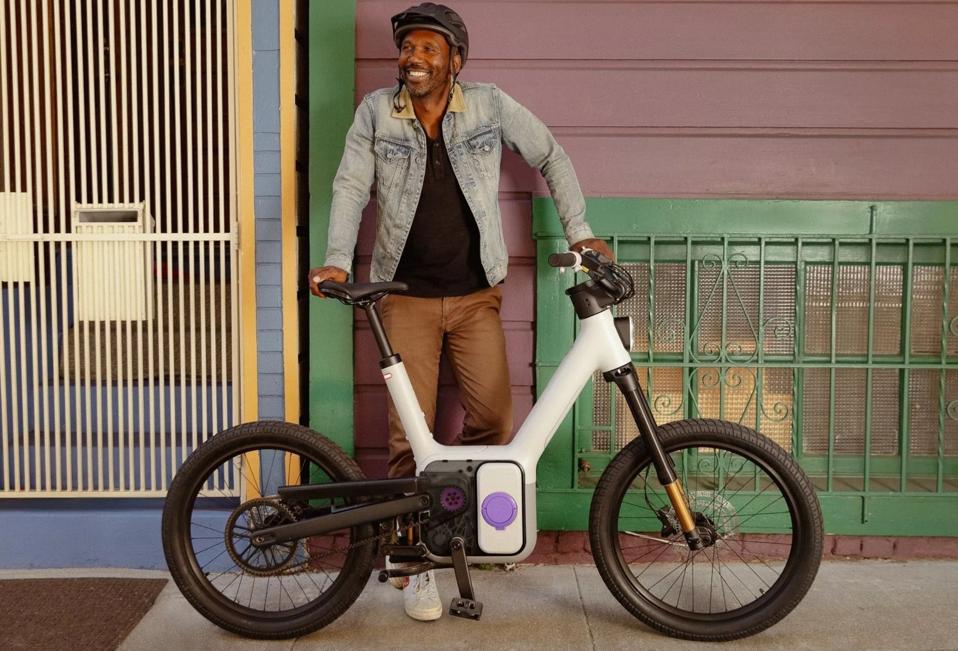Creating an e-bike today is fairly straightforward. Any startup can source parts from a wide range of frame, motor, and electronics makers, assemble a bike, slap a name on it, and enter the very crowded e-bike market to see what happens. If the bike performs well and is backed by some creative marketing, orders will start rolling in. It’s not rocket surgery, as the kids say.
That is definitely not the route Rivian thin-mobility spinoff ALSO took in creating its new ebike. While it certainly resembles a bicycle, the ideas behind it clearly show that the ALSO team examined nearly every aspect of e-bike technology and essentially asked: how can we do this differently and better?
Called the TM-B, ostensibly for Trancendent Mobility Bicycle, ALSO’s ebike casts a wide net and shakes up some now-common ebike tropes and assumptions.
ALSO TM-B Overview
Looking a bit like a cross between a bike from now-defunct ebike maker Cake and perhaps with a bit of Stromer mixed in, the ALSO TM-B e-bike in base form is a step-through design with full suspension, belt drive, a removable battery and all-purpose tires. Top speed is 28 mph – Class 3 in the U.S. – with pedal assist and 20mph on throttle alone.
But the bike itself is modular: the seatpost section is quick-release, and owners can quickly slot in a solo seat, a banana-type two-up perch or a cargo rack with kid seating.
From there, the TM-B begins to further depart the realm of regular ebikes. The pedals have no physical connection to the drivetrain, and there’s no derailleur or physical gearing per se, but users can define how the bike is “geared” and how much assist the motor provides.
When riders do pedal, they are actually turning a generator that adds in electricity for propulsion while also telling the motor how much power to output. The TM-B also features regenerative braking, which generates energy that is stored in the battery. They call the system DreamRide, and the motor outputs a staunch 132 pound-feet of torque. If the battery is run down to dead, the TM-B does have a limp mode to allow it to be pedaled home, or to a charger.
The battery itself is also quick-release and sits vertically in the DreamRide cluster at the heart of the bike. Buyers can get a 60-mile range battery for the base $4,000 price tag, or a larger 100-mile range battery for $500 more in the Launch and Performance editions, which also include uprated forks and some other bits. When the battery is out of the bike, it can be used as a power tap for charging small electronics.
Up top, a clever round touchscreen display with a control ring shows ride data and allows easy adjustment of the bike’s power and other settings. The TM-B can be tracked via GPS and remotely locked and unlocked via a smartphone app. When locked, the wheels are locked out so it can’t be rolled away. I’d still advise a strong bike lock to make sure it stays put.
Again, this is a full-bounce ebike, and Rivian/ALSO shows riders hammering it fairly aggressively on an off-road course, including getting some decent air on jumps. The suspension is air-adjustable with 120mm of travel front and rear. There is a special off-road riding option available as well, along with handlebar options.
The fact the TM-B can be quick-swapped from cargo/kid carrier to commuter to mountain bike makes for a wide range of riding options for any ebike, so we’ll have to see how it handles varied duties in an upcoming review.
The ALSO TM-B is expected to arrive in North American markets in spring of 2026. You can secure a TM-B of your own with a $50 deposit. ALSO says it will also be rolling out a quad-wheeled ebike and even a bike-lane friendly delivery vehicle based around the DreamRide technology in the near future (below).
Thank you for reading. Subscribing to Forbes.com allows you to leave comments and support contributors like myself. Subscribe to my Forbes.com page and get notifications when new stories are posted. You can also follow me on LinkedIn.

